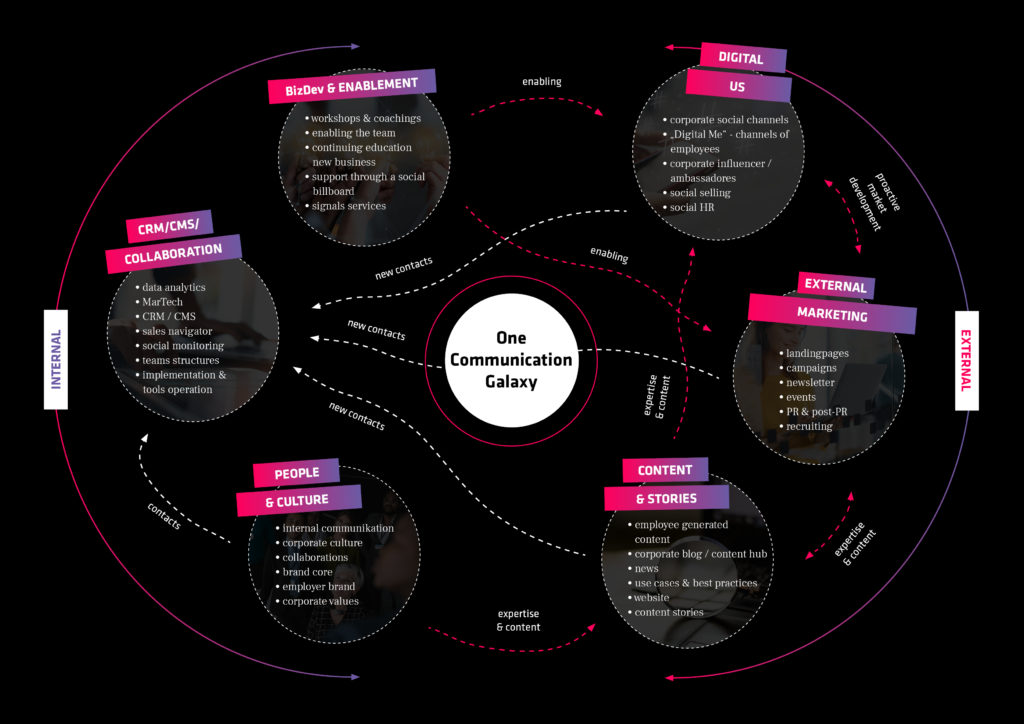
3 reasons why Lead Generation does not work
For a long time, lead generation was considered THE measure of all things when it came to marketing success. And many marketers will continue to hold this opinion. But the market has changed, and faster than many companies (could) react. We’ll show you the three big mistakes marketers make when it comes to LeadGen, how to avoid them, and which new approach will lead to success.
Three new approaches: How to make your digital campaigns a success!
When it comes to lead generation, one of the most important goals of many marketers (85% according to the Content Marketing Institute), opinions are divided: on the one hand, it is an established KPI that is considered a hard currency for the success of marketing strategies and activities; on the other hand, disappointments are often pre-programmed. Two-thirds of marketers describe lead gen as problematic, while just under one-fifth believe that outbound lead activities lead to valuable leads (sources: Apsis/Hubspot). Despite all this, marketing spend in this area is at a comparatively high level.
Evernine Group has been observing the development in the market for more than ten years and has thus been able to gain important insights. In order to implement successful digital lead generation campaigns, it requires a holistic approach. This is mainly due to the fact that the digital advertising market has exploded in the meantime. It has never been so easy to obtain provider information and make comparisons about products and services. This creates an enormous competitive environment. The wide range of communication options on the web is therefore both a curse and a blessing.
Factors leading to failure
One of the biggest misconceptions could be described as that increased pressure in marketing may not produce diamonds after all. When the pressure to generate business is so high that people only act tactically and out of necessity, it comes at the expense of strategic and operational campaign preparation. Database providers, publishers and agencies often fuel the hope that lead generation is very easy, fast and cheap to achieve. Sven Blaukat, Strategic Director of Evernine has a clear opinion on this: “Those who dream of a digital “lead gen machine” must be aware that this is not possible through quick, tactical measures. Building brand trust, excellent analysis of the customer journey, and time for test & optimize are basic requirements for business success.”
Brand trust is not “old school
In uncertain times, brand perception is more important than ever. It’s not just about a modern corporate logo, but about building trust and customer loyalty. Attributes such as purpose, language and sustainability are now part of standard communication. Sustainability means not only taking into account the important climate protection, but also economic efficiency over longer periods of time. A brand must create customer experiences to keep up with customer expectations. Brand trust can be created, for example, especially in B2B communication by conveying competence and brand ambassadors. Storytelling and a network of brand ambassadors is not a free skate here, but a duty.

In the QuickGuide, we show all marketers how lead generation can really lead to success. Including three completely new approaches for your digital campaigns.
Realistically assess expectations and timeline
If you plan purely tactically from quarter to quarter, it is difficult to establish or sharpen the brand in the long term. Among other things, always-on communication and the consideration of real sales cycles are important criteria for accompanying customers on their decision-making journey. The customer journey can be interrupted by potential customers at any time, either intentionally or unintentionally – in this case, it is all the more important that a provider remains in the conversation through positive experiences and creates return options. KPIs should not only be based on the number of leads, but metrics can be assessed in lead score, engagement, dwell time and future interest. This is valuable information that supports account-based marketing and social selling, among others.
Out of the box as a mindset
Creativity is not only important in consumer marketing. It is no longer news that decision-makers are also emotional people. Despite all this, marketers and product managers, especially in B2B, are still tempted by experience to rely on features and theoretical value-added information. Decision maker groups today are strongly business or department oriented – so problem solving and cost effectiveness must be quickly apparent. Trust and differentiation should be transported emotionally in the awareness phase. Decisions are made emotionally and later justified logically – this means: the content must fit exactly to the respective communication phase of the consumer.
Why the Evernine “Communication Galaxy” works
Word has spread that marketing and sales perform better when they simply break down their silos and work together. This has many benefits, including making the value of marketing efforts clear to all, ensuring smooth follow-up, and improving overall performance. The “Evernine Communications Galaxy” was developed because when working on client projects, the following happened again and again: tactical actions stalled because the holistic approach was missing. Business opportunities are wasted due to overly segregated areas of responsibility within organizations.
Breaking down silos, in Evernine’s view, involves the following areas, which include further subheadings: Content & Stories, External Marketing, People & Culture, CRM/MARTECH, Sales Enablement, DigitaUs/DigitalMe.
The aim should be for companies to network the individual areas and exploit synergies. This results in enormous potential for optimization and cost savings. A “One Voice Strategy” leads to effective communication across several levels and pays off for brand and demand generation.
How does an easy entry into smart lead generation happen?
“When the management board expects quick results, there is little time for strategy – I need results,” says an Evernine client. As an agency, we have therefore developed three entry points in the area of classic campaigns that create a low-threshold combination of strategic and tactical marketing. A distinction is made between the following start options:
- Strategic Campaigns Approach – here “hybrid” short-term and long-term goals are combined
- Brand Loyalty Approach – starting with brand and content challenges
- Sales/Tech Approach – analysis and correction of the interaction between martech and sales processes.
All three options open up entrenched thought patterns in the medium term and lead to a structured and at the same time agile and dynamic strategy. In practice, this approach also has the advantage that, depending on the marketing managers’ own experience, the largest gaps can be closed successively, including in the operational area. A starting point, for example, is a digital health check that analyzes the providers’ most important digital measures. In the area of content, it helps to take a closer look at all content and its distribution. A diagnosis of the customer journey reveals weak points in permeability and distribution. In martech and CRM, data weaknesses and problems in the transition to social selling are identified if necessary. The goal is always to create multipliers through a unified objective through communication and transparency. Optimizing multiple overarching factors pays dividends to the success of lead generation campaigns.
Conclusion
Digital lead generation campaigns can still be successful in 2023 – if they are developed and implemented with the right strategy and new approaches. To do this, silos must be broken down; it requires courage and creativity.
New approaches are now the order of the day, so as not to miss the boat in competition. In order to stand out from the mass of digital offerings and reach the desired target group with new (emotional) campaigns, the measures must always fit the company’s own brand. And then, but only then, can lead generation lead to the desired success.
Authors: Sven Blaukat, Stefanie Langhans / Titelbild: Evernine Group
For a long time, lead generation was considered THE measure of all things when it came to marketing success. And many marketers will continue to hold this opinion. But the market has changed, and faster than many companies (could) react. We’ll show you the three big mistakes marketers make when it comes to LeadGen, how to avoid them, and which new approach will lead to success.
When it comes to lead generation, one of the most important goals of many marketers (85% according to the Content Marketing Institute), opinions are divided: on the one hand, it is an established KPI that is considered a hard currency for the success of marketing strategies and activities; on the other hand, disappointments are often pre-programmed. Two-thirds of marketers describe lead gen as problematic, while just under one-fifth believe that outbound lead activities lead to valuable leads (sources: Apsis/Hubspot). Despite all this, marketing spending in this area is at a comparatively high level.
The Evernine Group has been observing developments in the market for over ten years and has thus been able to gain important insights. In order to implement successful digital lead generation campaigns, a holistic approach is required. This is mainly due to the fact that the digital advertising market has exploded in the meantime. It has never been so easy to obtain provider information and make comparisons about products and services. This creates an enormous competitive environment. The diverse possibilities of communication on the Web are thus both a curse and a blessing.
Factors that lead to failure
One of the biggest misconceptions could be described as that increased pressure in marketing may not produce diamonds after all. When the pressure to drum up business is so high that only tactical and emergency actions are taken, it comes at the expense of strategic and operational campaign preparation. Database providers, publishers and agencies often fuel the hope that lead generation is very easy, fast and cheap to achieve. Sven Blaukat, Strategic Director of Evernine has a clear opinion on this: “Those who dream of a digital “lead gen machine” must be aware that this is not possible through quick, tactical measures. Creating brand trust, excellent analysis of the customer journey, and time for test & optimize are basic requirements for business success.”
Brand trust is not “old school”
In uncertain times, brand perception is more important than ever. It’s not just about a modern corporate logo, but about building trust and customer loyalty. Attributes such as purpose, language and sustainability are now part of standard communication. Sustainability means not only taking into account the important climate protection, but also economic efficiency over longer periods of time. A brand must create customer experiences to keep up with customer expectations. Brand trust can be created, for example, especially in B2B communication by conveying competence and brand ambassadors. Storytelling and a network of brand ambassadors is not a free skate here, but a duty.
In the QuickGuide, we show all marketers how lead generation can really lead to success. Including three completely new approaches for your digital campaigns
Realistically assess expectations and timeline
If you plan purely tactically from quarter to quarter, it is difficult to establish or sharpen the brand in the long term. Among other things, always-on communication and the consideration of real sales cycles are important criteria for accompanying customers on their decision-making journey. The customer journey can be interrupted by potential customers at any time, either intentionally or unintentionally – in this case, it is all the more important that a provider remains in the conversation through positive experiences and creates return options. KPIs should not only be based on the number of leads, but metrics can be assessed in lead score, engagement, dwell time and future interest. This is valuable information that supports account-based marketing and social selling, among others.
Out of the box as a mindset
Creativity is not only important in consumer marketing. It is no longer news that decision-makers are also emotional people. Despite all this, marketers and product managers, especially in B2B, are still tempted by experience to rely on features and theoretical value-added information. Decision maker groups today are strongly business or department oriented – so problem solving and cost effectiveness must be quickly apparent. Trust and differentiation should be transported emotionally in the awareness phase. Decisions are made emotionally and later justified logically – this means: the content must fit exactly to the respective communication phase of the consumer.
Why the Evernine “Communication Galaxy” works
Word has spread that marketing and sales perform better when they simply break down their silos and work together. This has many benefits, including making the value of marketing efforts clear to all, ensuring smooth follow-up, and improving overall performance. The “Evernine Communications Galaxy” was developed because when working on client projects, the following happened again and again: tactical actions stalled because the holistic approach was missing. Business opportunities are wasted due to overly segregated areas of responsibility within organizations.
Breaking down silos, in Evernine’s view, involves the following areas, which include further subheadings: Content & Stories, External Marketing, People & Culture, CRM/MARTECH, Sales Enablement, DigitaUs/DigitalMe.
“The aim should be for companies to network the individual areas and exploit synergies. This results in enormous potential for optimization and cost savings. A “One Voice Strategy” leads to effective communication across multiple levels and pays off for brand and demand generation,” says Sven Blaukat, Director Strategy Consulting at Evernine.
How does an easy entry into smart lead generation happen?
“When the management board expects quick results, there is little time for strategy – I need results,” says an Evernine client. As an agency, we have therefore developed three entry points in the area of classic campaigns that create a low-threshold combination of strategic and tactical marketing. A distinction is made between the following start options:
- Strategic Campaigns Approach – here “hybrid” short-term and long-term goals are combined
- Brand Loyalty Approach – starting with brand and content challenges
- Sales/Tech Approach – analysis and correction of the interaction between martech and sales processes.
All three options open up entrenched thought patterns in the medium term and lead to a structured and at the same time agile and dynamic strategy. In practice, this approach also has the advantage that, depending on the marketing managers’ own experience, the largest gaps can be closed successively, including in the operational area. A starting point, for example, is a digital health check that analyzes the providers’ most important digital measures. In the area of content, it helps to take a closer look at all content and its distribution. A diagnosis of the customer journey reveals weak points in permeability and distribution. In martech and CRM, data weaknesses and problems in the transition to social selling are identified if necessary. The goal is always to create multipliers through a unified objective through communication and transparency. Optimizing multiple overarching factors pays dividends to the success of lead generation campaigns.
Conclusion
Digital lead generation campaigns can still be successful in 2023 – if they are developed and implemented with the right strategy and new approaches. To do this, silos must be broken down; it requires courage and creativity.
New approaches are now the order of the day, so as not to miss the boat in competition. In order to stand out from the mass of digital offerings and reach the desired target group with new (emotional) campaigns, the measures must always fit the company’s own brand. And then, but only then, can lead generation lead to the desired success.









